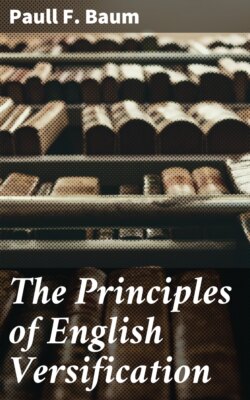Читать книгу The Principles of English Versification - Paull F. Baum - Страница 8
На сайте Литреса книга снята с продажи.
RHYTHM OF PROSE AND VERSE
ОглавлениеTable of Contents
It is clear now that all language is more or less definitely rhythmical; and that the two fundamental and determining elements of speech-rhythm are time and stress. It is clear also that the essential thing in our perception of rhythm is the experience or recognition of groups, these groups being themselves distinguished and set off by stress and time. When there is an easily felt regularity of the groups, when the alternation of stress and unstress and the approximate equality of the time intervals are fairly apparent, then the rhythm is simple. When the regularity is not obvious, the rhythm is complex, but none the less existent and pleasing.[12] In other words, the character of language rhythm is determined by the relative proportion of coincidence and syncopation. In verse, coincidence preponderates; in prose, syncopation (and substitution). Between absolute coincidence, moreover, and the freest possible syncopation and substitution, infinite gradations are possible; and many passages indeed lie so close to the boundary between recognizable preponderance of the one or of the other that it is difficult to say this is verse, that is prose. Various standards and conventions enter into the decision.
For practical convenience three main sorts of rhythmic prose may be distinguished: (1) characteristic prose, or that in which no regularity (coincidence) is easily appreciable; (2) cadenced prose, or that in which the regularity is perceptible, but unobtrusive, and (3) metrical prose, or that in which the regularity is so noticeable as to be unpleasing. No very clear lines can be drawn; nor should one try to classify more than brief passages in one group or another. And, obviously, longer selections will combine two or more sorts in succession. A few examples will serve to show what is meant.
Characteristic Prose. No prose, as has been said above, is without rhythmic curves; but the best prose, that which always keeps in view the best ideals of prose, carefully avoids consecutive repetitions of the same rhythmic patterns. It is the distinction of verse to follow a chosen pattern, with due regard to the artistic principles of variety and uniformity; it is the distinction of prose to accomplish its object, whether artistic or utilitarian, without encroaching on the boundaries of its neighbor. Prose may be as 'poetic,' as charged with powerful emotion, as possible, but it remains true prose only when it refuses to borrow aids from the characteristic excellences of verse.
To be sure, it is not always easy to avoid regular patterns in writing the most ordinary prose. They come uncalled; they seem to be inherent in the language. Here is, chosen casually, the first sentence of a current news item, written surely without artistic elaboration, and subjected, moreover, to the uncertainties of cable transmission. It was no doubt farthest from the correspondent's intention to write 'numerous' prose; but notice how the sentence may be divided into a series of rhythmic groups of two stresses each, with a fairly regular number of accompanying unstressed syllables:
